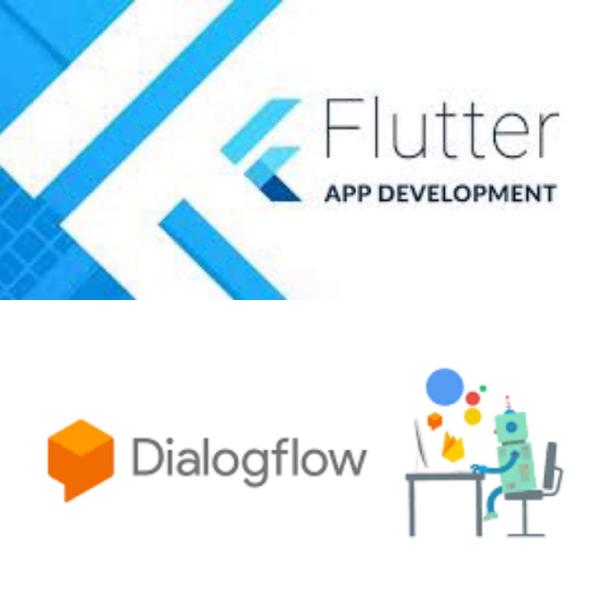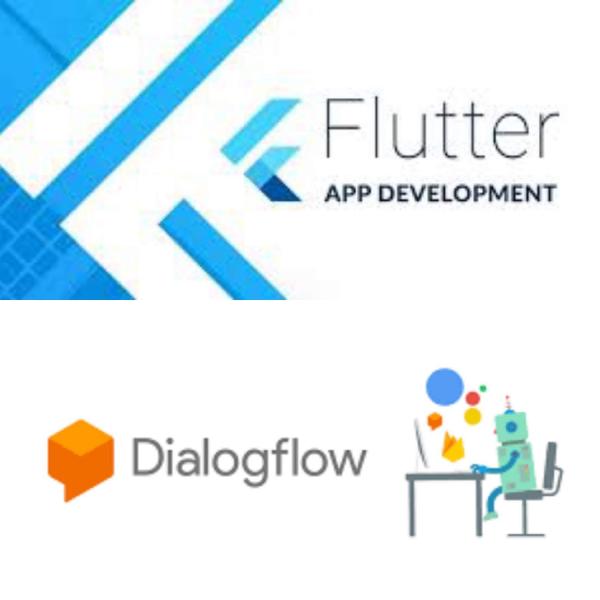ChatBot

Quando Flutter incontra DialogFlow nasce un ChatBot multi piattaforma
In questi giorni ho voluto sperimentare e approfondire le conoscenze in ambito di chatbot, ho fatto questa scelta perchè, in questo momento, questa tecnologia è molto utilizzata e molto in crescita. Un pò di teoria I chatbot esistono da tempo, davvero da tanto tempo, risalgono ai primi anni 60/70 con ELIZA e PARRY. Questi due progetti sono nati con lo scopo di creare una conversazione simulata con una macchina. In molti casi, questi due chatbot sono riusciti ad ingannare le persono coinvolte, utilizzando però risposte molto vaghe. Tuttavia, questi due progetti, nonostante fossero classificati come chatbot, risultavano essere molto stupidi, difatto non hanno la stessa concezione del chatbot odierno. Il software che c’era dietro ai vecchi chatbot era molto semplice, possiamo vederlo come una mappatura uno a uno ( domanda -> risposta). Non era presente alcuna interpretazione della domanda. La maggior parte dei Chatbot moderni invece utilizzano il linguaggio naturale che possiamo immaginare con la composizione di tre elementi principali: analisi lessicale (scomposizione frase in token) analisi grammaticale (associazione parti del discorso) analisi sintattica (arrangiamento token in una struttura ad albero) analisi semantica (assegnazione di un significato) Così descritto sembra semplice e noi umani siamo in grado di farlo senza sapere che esistono tutti questi step. Insegnare ad una macchina l’elaborazione degli step sopra elencati è davvero difficile. In particolar modo l’ultimo punto dell’analisi semantica. Oggigiorno I Chatbot più comuni che utilizziamo senza quasi rendercene conto sono Ok Google, Alexa, Siri, Cortona e ogni giorno ne sono presenti sempre di più e di nuovi. Gli ambiti in crescita dove vengono maggiormente utilizzati sono banche, servizio clienti e e-commerce. Ma perchè i chatbot si chiamano con nomi propri di persona? Non ho trovato questa risposta online però credo che la risposta possa essere semplice! Dovendo interagire con qualcosa dalle sembianze umane, quale potrebbe essere il miglior modo per interagire se non quello di attribuire un nome con cui possiamo chiamarlo? Quasi tutte le interazioni con altre persone iniziano con il nome proprio della persona, serve per richiedere la sua attenzione. Cosa c’è dietro al cofano? Ma cosa c’è dietro questi Chatbot? Nel caso di Ok Google, il servizio nelle retroscene è proprio DialogFlow, Questo servizio messo a disposizione di tutti, permette a tutti in modo agile di creare un un vero e proprio chatbot in pochi step e senza alcuna conoscenza di programmazione. Il concetto è molto facile, si basa sulla creazione di Intenti e risposte. Vi spiegherò in questo articolo come utilizzare DialogFlow e come implementarlo usando Flutter. Perchè Flutter? Perchè credo sia molto in crescita al momento. Il progetto sta crescendo così tanto da essere compatibile con tante piattaforme. In particolar modo funziona in maniera nativa su Android e IOS e funziona davvero alla grande. Secondo i test fatti, ha delle prestazioni quasi pari ai linguaggi nativi (Java/Swift/c++). Nonostante sia ancora in Beta, la funzione in modalità web va alla grande e funziona anche per ambienti desktop (linux e Windows). Ma cosa manca? ah già! Tv e Smartwatch! credo però che arriverà a breve anche li il supporto, se ne comincia a parlare online! Mi fai vedere il codice? Non voglio entrare nel dettaglio della configurazione del progetto di dialog flow in quanto ci sono davvero tanti tutorial ben fatti. Do per scontato che abbiate installato Flutter. Se non l’avete ancora fatto, potete partire da questa guida. Dopo aver installato Flutter, visto che la sua concezione è Mobile, se volete compilare anche per web dobbiamo eseguire i seguenti comandi: //abilito la verisone web di flutter flutter channel master flutter upgrade flutter config --enable-web //creo e faccio il run di un nuovo progetto cd into project directory flutter create . flutter run -d chrome Una volta abilitata la versione web di flutter e creato il progetto, possiamo procedere con la modifica del file pubspec.yaml. Questo file contiene le configurazioni e dipendenze ai plugin che utilizziamo nel nostro progetto. Dobbiamo quindi aggiungere le dipendenze a DialogFlow, la versione compatibile sia per web che per mobile è la seguente: flutter_dialogflow: ^0.1.3 assets: - assets/yourapifile.json Dobbiamo anche aggiungere negli asset il file json scaricato da google cloud relativo al service account che ha accesso al progetto di DialogFlow. l’implementazione di dialog Flow richiede davvero poco, giusto qualche riga di codice per l’inizializzazione: dialogFlow.AuthGoogle authGoogle = await dialogFlow.AuthGoogle(fileJson:"assets/yourapifile.json").build(); dialogflow = dialogFlow.Dialogflow(authGoogle: authGoogle); Infine, chiediamo a DialogFlow l’elaborazione dell’intent in modo da ricevere una risposta, con la seguente riga di codice: dialogFlow.AIResponse response = await dialogflow.detectIntent(query); print(response.getMessage()); Potete trovare l’intera implementazione funzionante al seguente link Github. Per poterlo utilizzare, dovrete solo aggiungere la vostra chiave Json del vostro account di servizio, che dovrete creare su google cloud e associare a DialogFlow. schermata del risultato finale:

When Flutter meat DialogFlow born a multi platform ChatBot
In these days, I wanted to experiment and deepen my knowledge in the field of chatbot, I made this choice because at this moment, this technology is widely used and really growing. A little theory Chatbots have been around for a long time, really for a long time, they date back to the early 60s70s with ELIZA and PARRY. These two projects were born for the purpose of creating a simulated conversation with a machine. In many cases, these two chatbots have managed to deceive the people involved, but using very vague but intelligent answers. These two projects, however, despite being classified as chatbots, were very stupid, they do not have the same conception of today’s chatbot. The software behind the old chatbots was very simple, we can see it as a one-to-one mapping (question -> answer). There was no interpretation of the question. Most modern Chatbots, on the other hand, use natural language that we can imagine with the composition of three main elements: lexical analysis (decomposition of sentence into token) grammatical analysis (association of parts of speech) syntactic analysis (token arrangement in a tree structure) analysis semantics (assigning a meaning) Thus described it seems simple and we as humans are able to do it without knowing the existence of all these steps. Teaching a machine how to process the steps listed above is really difficult. Especially the last point of the semantic analysis. Nowadays the most common Chatbots that we use without realizing it are Ok Google, Alexa, Siri, Cortona and every day there are more and more new ones. The growing areas where they are most used are banks, customer service and e-commerce. But why are chatbots called by personal names? I have not found this answer online but I believe the answer is simple. As we have to interact with something with human features, what could be the best way to do it, if not to give a name with which we can call it? Almost all interactions with other people begin with the person’s first name, it is needed to request his/her attention. What’s behind the hood? But what’s behind these Chatbots? In the case of Ok Google, the service in the background is just DialogFlow, This service made available to everyone, allows everyone in an agile way to create a real chatbot in a few steps and without any programming knowledge, the concept is very easy, it is basically based on the creation of intents and answers. I will explain in this article how to use DialogFlow and how to implement it using Flutter. Why Flutter? Because I think it is really growing at the moment. The project is growing so much that it is compatible with many platforms. In particular, it works natively on Android and IOS and works really well, according to the tests made, it has performances almost equal to the native languages (Java / Swift / c ++). Although still in Beta, the Web function is going great, and it also works for desktop environments (linux and Windows). What is missing? Just TV and Smartwatch, I believe that the support will arrive shortly! Can you show me the code? I don’t want to go in detail in DialogFlow configuration, there are really many good tutorials that explain the setup and how to use it. I assume that you have Flutter installed. If you haven’t, you can start from this guide. After installing Flutter, since its conception is Mobile, if you want to compile also for web you must execute the following commands: //enable web flutter versione flutter channel master flutter upgrade flutter config --enable-web //new web project and run in chrome cd into project directory flutter create . flutter run -d chrome Once the web version of flutter has been enabled and the project has been created, we can proceed by update the pubspec.yaml file. This file contains the configurations and dependencies to the plugins that we use in our project. We must therefore add the dependencies to DialogFlow, the compatible version for both web and mobile is as follows: flutter_dialogflow: ^0.1.3 assets: - assets/yourapifile.json We must also add in the assets the json file downloaded from google cloud relating to the service account that has access to the DialogFlow project. The implementation of dialog Flow requires very little, just a few lines of initialization code: dialogFlow.AuthGoogle authGoogle = await dialogFlow.AuthGoogle(fileJson:"assets/yourapifile.json").build(); dialogflow = dialogFlow.Dialogflow(authGoogle: authGoogle); Finally we have to ask DialogFlow to process the intent in order to receive a response, do this with the following line of code: dialogFlow.AIResponse response = await dialogflow.detectIntent(query); print(response.getMessage()); The whole working implementation can be found at the following link Github. In order to use it, you only need to add your service account Json key, which you will have to create on Google Cloud and associate it with DialogFlow. final result screen: